-
current
recommendations- Liefdefjord
New page dedicated to one of Spitsbergen's most beautiful fjords. Background information and many photos.
- New Spitsbergen guidebook
The new edition of my Spitsbergen guidebook is out and available now!
- Liefdefjord
New page dedicated to one of Spitsbergen's most beautiful fjords. Background information and many photos.
Page Structure
-
Spitsbergen-News
- Select Month
- June 2025
- May 2025
- April 2025
- March 2025
- February 2025
- January 2025
- December 2024
- November 2024
- October 2024
- September 2024
- August 2024
- July 2024
- June 2024
- May 2024
- April 2024
- March 2024
- February 2024
- January 2024
- December 2023
- November 2023
- October 2023
- September 2023
- August 2023
- July 2023
- June 2023
- May 2023
- April 2023
- March 2023
- February 2023
- January 2023
- December 2022
- November 2022
- October 2022
- September 2022
- August 2022
- July 2022
- June 2022
- May 2022
- April 2022
- March 2022
- February 2022
- January 2022
- December 2021
- November 2021
- October 2021
- September 2021
- August 2021
- July 2021
- June 2021
- May 2021
- April 2021
- March 2021
- February 2021
- January 2021
- December 2020
- November 2020
- October 2020
- September 2020
- August 2020
- July 2020
- June 2020
- May 2020
- April 2020
- March 2020
- February 2020
- January 2020
- December 2019
- November 2019
- October 2019
- September 2019
- August 2019
- July 2019
- June 2019
- May 2019
- April 2019
- March 2019
- February 2019
- January 2019
- December 2018
- November 2018
- October 2018
- September 2018
- August 2018
- July 2018
- June 2018
- May 2018
- April 2018
- March 2018
- February 2018
- January 2018
- December 2017
- November 2017
- October 2017
- September 2017
- August 2017
- July 2017
- June 2017
- May 2017
- April 2017
- March 2017
- February 2017
- January 2017
- December 2016
- November 2016
- October 2016
- September 2016
- August 2016
- July 2016
- June 2016
- May 2016
- April 2016
- March 2016
- February 2016
- January 2016
- December 2015
- November 2015
- October 2015
- September 2015
- August 2015
- July 2015
- June 2015
- May 2015
- April 2015
- March 2015
- February 2015
- January 2015
- December 2014
- November 2014
- October 2014
- September 2014
- August 2014
- July 2014
- June 2014
- May 2014
- April 2014
- March 2014
- February 2014
- January 2014
- December 2013
- November 2013
- October 2013
- September 2013
- August 2013
- July 2013
- June 2013
- May 2013
- April 2013
- March 2013
- February 2013
- January 2013
- December 2012
- November 2012
- October 2012
- September 2012
- August 2012
- July 2012
- June 2012
- May 2012
- April 2012
- March 2012
- February 2012
- January 2012
- December 2011
- November 2011
- October 2011
- September 2011
- August 2011
- May 2011
- April 2011
- March 2011
- February 2011
- January 2011
- December 2010
- November 2010
- September 2010
- August 2010
- July 2010
- June 2010
- May 2010
- April 2010
- March 2010
- February 2010
- November 2009
- October 2009
- August 2009
- July 2009
- June 2009
- May 2009
- April 2009
- March 2009
- February 2009
- January 2009
- December 2008
- November 2008
- October 2008
- August 2008
- July 2008
- June 2008
- May 2008
- April 2008
- March 2008
- February 2008
- April 2000
- Select Month
-
weather information
-
Newsletter

| Guidebook: Spitsbergen-Svalbard |
Home
→ January, 2021
Monthly Archives: January 2021 − News & Stories
Norway tightens travel restrictions and requires tests for travellers to Spitsbergen
Many countries have introduced restrictions on travelling in an attempt to keep the new versions of the SarsCov-2 (corona) virus under control. Norway has also had a number cases with these new viruses recenty and tightens in on regulations for international traffic to reduce further spreading, according to a press release by the Norwegian government, which is also available in English (click here).

Applies to all of Spitsbergen: Corona-quarantine.
Compulsory corona testing has now additionally been introduced (photo composition).
Since today (Friday, 01 January) everybody who travels to Spitsbergen has to be tested within 24 hours before travelling. This has to be done before travelling, hence on the mainland and not after arrival.
Rapid tests are also accepted, acording to Knut Selmer, medical doctor at the hospital in Longyearbyen, who talked to Svalbardposten.
New regulations for drones
New regulations for drones are in force since 01 January 2021. Drones weighing more than 250 g or that have a camera need to be registered at the Norwegian air traffic authority air traffic authority (Luftfartstilsynset). This includes a web-based course, a test and a fee. Everybody who wants to use a drone in Svalbard (or mainland Norway, for that sake) will need to go through that, unless the drone weighs less than 250 g and does not have a camera.

No flight zone around Longyearbyen and the most important rules for drones in Svalbard (Sysselmannen. Follow the link to get a high resolution file).
The most important rules are given on the Sysselmannen’s website. These include amongst others:
- Registration, course and test, see above.
- General no flight zones within 5 km distance from the airports in Longyearbyen and Sveagruva. This includes almost all of Longyearbyen!
- General no flight zones within 20 km distance around Ny-Ålesund (radio silence zone to avoid disturbance of sensitive scientific instruments). This includes the whole Kongsfjord.
- Disturbance of wildlife and humans is generally forbidden. Respect peoples’ privacy (minimum distance from people, buildings, boats etc.: 150 m).
- Maximum flight altitude above ground: 120 m.
- The drone must remain within eyesight.
- Flying in darkness is not allowed.
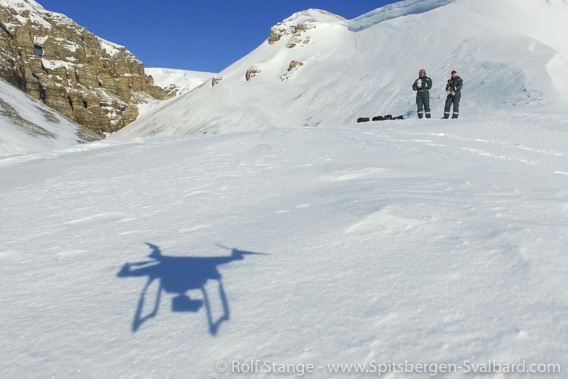
New rules for drones are in force from 01 January 2021.
Expansion of Nordenskiöld Land national park
Nordenskiöld Land Nationalpark includes the southern part of Nordenskiöld Land, in other words the north coast of Bellsund. This national park is now under review and the plan is to make it much larger. The idea is to include almost all of Van Mijenfjord and large parts of Van Keulenfjord. The south side of Van Keulenfjord are already part of the South Spitsbergen national park. The result would hence be that all of Spitsbergen south of Nordenskiöld Land, from Van Mijenfjord to Sørkapp, would have protection status as national park.

Blue: the scheduled expansion of Nordenskiöld Land national park.
Map © Sysselmannen på Svalbard.
Public hearing
The process is currently in the stage of public hearing. The public is encouraged to give input to the Sysselmannen.
Restrictions for snow mobiles, new bird sanctuaries
A larger Nordenskiöld Land national park is likely to involve several restrictions for public traffic, including restrictions for motorized traffic (snow mobiles) on the fjord ice of Van Mijenfjorden. This is mainly targetet against snow mobile traffic to Rindersbukta and Akseløya. In addition, 3 new bird sanctuaries are planned in locations that have high concentrations of resting and breeding birds, mainly common eider ducks, barnacle geese and pink-footed geese. The locations currently in question are Mariaholmen (near Akseløya), Eholmen (near Forsbladodden) and Midterhuksletta.
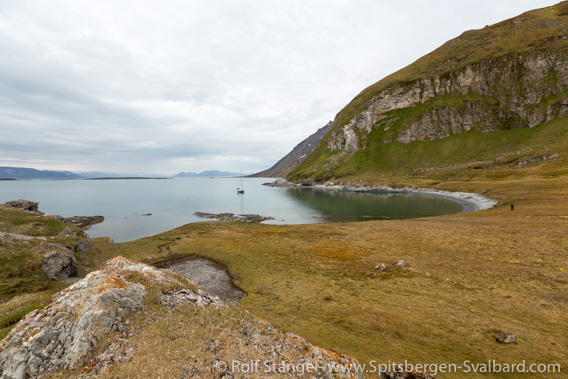
The expansion of the Nordenskiöld Land national park may bring traffic restrictions in several new bird sanctuaries, incuding Midterhuksletta.
Parts of the former settlement of Sveagruva, which is largely being removed these days, are currently not included in the enlarged national park.
The course of things up north
No new here for a week or more, is there nothing going on in Spitsbergen? Indeed, the far north has not shaken the world recently. But there is always something going. Not just corona – it is a long page, stay tuned! 😉
Corona, Corona, Corona
Corona is obviously commanding the world these days, and that is also the case in Spitsbergen. Even though there has not yet been any cofirmed infection with SARS-Cov-2. Last summer, the virus was already there with a Hurtigruten ship, but it didn’t stay as there was no contact between the ship and the settlement, the trip started and finished in mainland Norway.
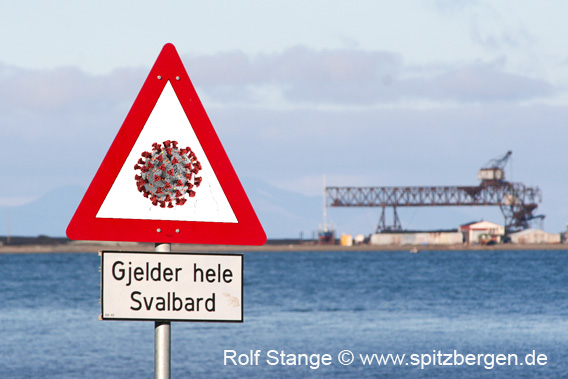
The corona virus still has the world in its firm grip, including Spitsbergen.
There is still some tourism in Longyearbyen: a few tourists come from the Norwegian mainland. There are, of course, strict rules. And locals return after their Christmas holidays or whatever they have done, potentially giving the virus a lift. In one case, it turned out that someone who had returned to Longyearbyen had been a contact of someone with a confirmed infection. So far, reduced contacts and other safety measures seem to have worked fine. On the other hand, a few of Longyearbyen’s oldest inhabitants already got the first dose of the SARS-Cov-2 vaccine.
Regulations for international travellers are still very strict, obviously, and international tourism up north is practically non-existing these days.
Corona: hard on the economy
Consequences for local companies are dramatic, especially within tourism. And bridging aid are more difficult than on the mainland, partly because of Spitsbergen’s special status. But important steps have been taken in recent weeks. Still, many can just hope for improvement before their jobs or small companies get lost. The important winter season, usually peaking from February to early May, will hardly happen as it normally does.

Winter tourists in Spitsbergen: nobody knows when this will be possible again, but many are waiting desperately.
Powering Longyearbyen up
The future of Longyearbyen’s electricity supply has been debated for a long times. The state of the discussion is still pretty much like the summary given in December. In very short words: a new solution is needed, and it is likely to be based on something different than coal, at least partly. But now Oslo officials have said that this will have consequences for mine 7, Longyearbyen’s last coal mine. It is obvious that the years of coal mining will come to an end in the not too far future. So far, something near 2030 seemed likely. Now it may actually be earlier than that. But final decisions have yet to be made.

Mine 7 near Longyearbyen still has some years left, but the end of coal mining is coming closer.
Cash troubles
The end of Svalbard’s one and only bank in Longyearbyen was reason for some excitement in 2020. The bank closed for good in December. The ATM had already been out of operation for quite a while, because it turned out to be increasingly difficult to get cash from the mainland to Longyearbyen. Currently, there is no supply of fresh cash in Longyearbyen. Difficulties arising because of that seem to be limited, as cashless payment methods are very common in Norway and there is no international traffic these days. But at the latest when tourists start to return from countries outside Scandinavia, problems will increase if there is no cash locally available. The supermarket, Coop Svalbard (better known as Svalbardbutikken), may be able to provide a solution.
On my own behalf: Book and poster “Svalbardhytter”
I have got several projects in progress. Some of them are larger ones and these will require time to get anywhere near publication, but another one is soon to be finished: Originally considered to be “only” a poster, “Svalbardhytter” (Svalbard huts) is now a combination of a poster and a book, introducing 60 historical huts. Huts are interesting and often beautiful places in the Arctic. In the past, they offered at least a minimum of safety and comfort, and today, they give a sense of adventure and history. And, of course, any visit to a hut in Spitsbergen, wherever it is, is always an excursion in a beautiful area!
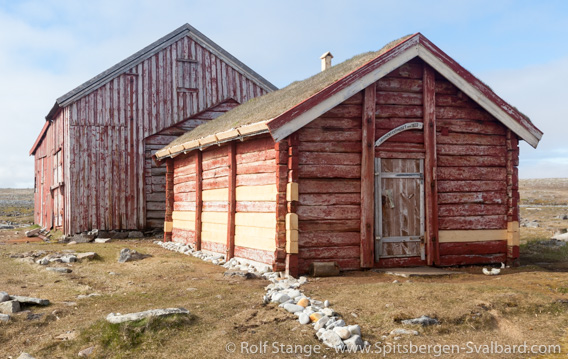
Hammerfest house on Bear Island (Bjørnøya) was built in 1822. This makes it Svalbard’s oldest building that is still standing. It is one of 60 huts introduced in the post and book project “Svalbardhytter”.
The Norwegian title seems to indicate a cryptic text, but this is not the case: the poster is a collage of 60 photos and place names, and the little book has some information about every one of them in 3 languages: German, English and Norwegian. And it does also have the photos.
“Svalbardhytter” will soon be available in the Spitzbergen.de online shop with is closely associated with this website. If you want to make sure that you don’t miss it, just sign up to my email newsletter by sending a message to rolf.stange@spitzbergen.de.
On my own behalf: online presentation series “Arctic Wednesday”
Our series of online presentations “the Arctic Wednesday” has started last Wednesday with my presentation about Bear Island and Jan Mayen. I am happy to say that it was very successful – I may not quite be neutral, but I got a lot of very positive feedback so I can be certain that this is the truth 🙂 Birgit Lutz and I will continue the series over another couple of weeks until mid February. Click here for more information. The talks will be in German.
The Arctic Wednesday: polar online presentations starting next week
Next week, Birgit Lutz and I (Rolf Stange) will start the “Arctic Wednesday”! A series of online presentations where we can pick up selected topics. Let’s travel together online to the beautiful, cold ends of the world! We will start on 13 January with a tour to Bear Island and Jan Mayen, followed later by a series of another five dates, every Wednesday for six weeks in total. Birgit and I have selected a range of topics ranging from adventure and travel through history to environment, which we hope you will enjoy.
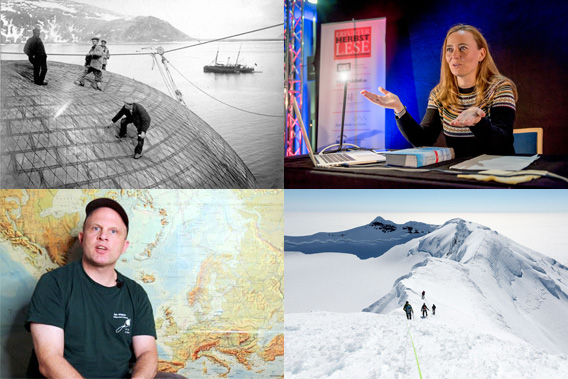
The Arctic Wednesday: polar online presentations with Birgit Lutz and Rolf Stange.
The presentations will be in German. I know there are a lot of German-speaking visitors to the English site, for example from the Netherlands – this is why I include this brief note here in English. For further information, please refer to the German version of this page (change language by clicking on the flagg symbol on top of this page).
- gallery anchor link: #gallery_1889
Click on thumbnail to open an enlarged version of the specific photo.
More crevasses on Spitsbergen’s glaciers
First of all: happy new year!
Many of Spitsbergen’s glaciers have “always” had a lot of crevases, while others are considered good traffic ways for those moving around in the arctic wilderness. This is – was? – the case especially for many of Spitsbergen’s smaller glaciers that terminate with a gentle slope on land, rather than with a calving front at sea level. The smaller ones, ending on land, usually move more slowly, which creates less stress in the ice and hence fewer crevasses.
More crevasses on classical “touring glaciers”
This has appearently changed for at least a number of glaciers, as the Sysselmannen established during a helicopter inspection of frequently travelled glaciers in Nordenskiöld Land in October 2020. It turned out that some of these glaciers had significantly more crevasses than they used to have in the past.
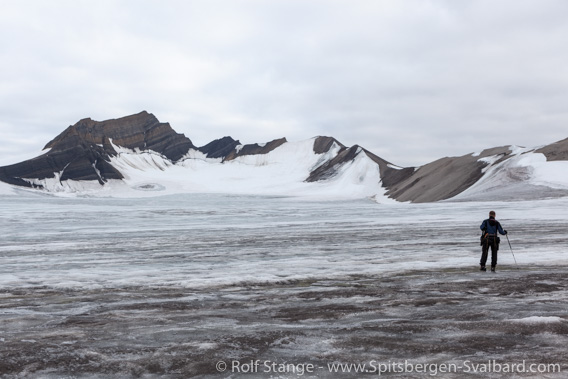
Many of Spitsbergen’s glacier have been thought to have few crevasses only, which made them comparatively easy touring terrain …
Another factor relevant for safety on glaciers is snow, which can build up snow bridges over crevasses. Such bridges are fine when they are strong and safe, but they can be very dangerous traps if they are too thin to be strong enough, but thick enough to hide the crevasse. The summer of 2020 was at times extremely warm and has melted a lot of snow also on the higher parts of the glaciers. Snow bridges have build up again from zero.
Safety and responsibility
Everybody who is out in the field in arctic terrain, be it with snow mobile, hiking, skiing, dog sledge, … should be careful and take adequate safety measures, especially in glaciated terrain. That has always been true and now this seems to be more relevant than before at least on some of Spitsbergen’s frequently travelled glaciers, and most likely also on other ones. In the press release, the Sysselmannen made it very clear that anyone who is on tour is him-/herself responsible for his/her own safety. Just in case anyone needed a reminder.
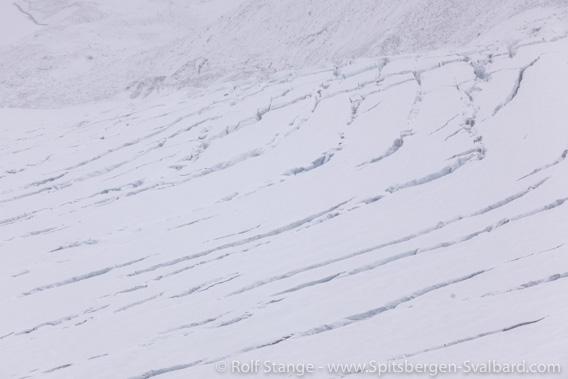
… but this has changed for at least some of them. Crevasses like the ones seen here are life dangerous, especially when they are hidden under snow.
The Sysselmannen has published a pdf with photos and maps that show some of the glaciers and crevasse fields in question.
The reasons are not yet scientifically established. It would be natural to assume that the velocity of shrinking glaciers is decreasing rather than the opposite. For a bit of speculation, it may appear reasonable to think that the extra meltwater supply during the warm summer of 2020 has decreased the internal friction of the glaciers, which may lead to greater speed and thus greater mechanical stress, hence more crevasses.
News-Listing live generated at 2025/June/15 at 03:44:03 Uhr (GMT+1)





































